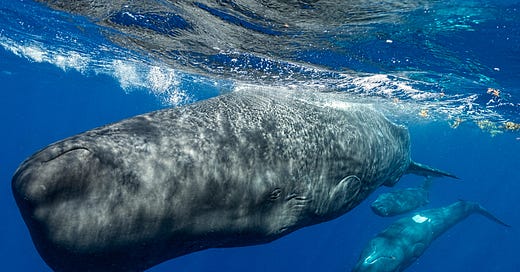Subscribe to Genomely for the latest discoveries and in-depth analyses in your inbox.
Thank you to our subscribers for your continued support and passion for science!
The ocean's vast depths have long hidden the life of its largest inhabitants—the sperm whales. These enigmatic creatures, known for their massive brains and complex social structures, have fascinated humans for centuries. Recent research is beginning to illuminate sperm whale communication, revealing a sophisticated language that challenges our understanding of non-human communication systems. Decoding the sperm whale language may pave the way for language-based communication between humans and other species, even extra terrestrials.
The Mystery of Whale Song
Sperm whales have captivated scientists and the public with their mysterious vocalizations, often called "codas." These are rhythmic patterns of clicks that sperm whales use to communicate with one another. The complexity of these sounds suggests a more advanced language than previously understood.
Researchers from the Massachusetts Institute of Technology's (MIT) Computer Science and Artificial Intelligence Laboratory (CSAIL) and the Project CETI (Cetacean Translation Initiative) have been at the forefront of decoding this cetacean language. Using advanced machine learning algorithms, they have begun to uncover the foundational elements of sperm whale communication.
The Phonetic Alphabet of Sperm Whales
In a study published in Nature Communications, the team detailed their findings on the sperm whale "phonetic alphabet." This research analyzed over 9,000 codas collected from sperm whale populations in the Eastern Caribbean. The findings revealed that these vocalizations are not random but possess a complex structure with context-sensitive and combinatorial elements.
The researchers identified four main elements in the whale codas: rhythm, tempo, rubato (or expressive shaping), and ornamentation. These elements interact to create distinct codas, like how human languages use phonemes to construct words and sentences. For instance, whales might modulate the duration of their clicks (rubato) or add ornamental clicks to convey different meanings.
Advanced Communication Systems
The discovery of these structured vocal patterns suggests that sperm whale communication may involve a form of syntax, a hallmark of complex language systems. This challenges the long-held belief that sophisticated communication is unique to humans. Daniela Rus, director of CSAIL, emphasized the significance of these findings: "Our findings indicate the presence of structured information content and also challenges the prevailing belief among many linguists that complex communication is unique to humans."
This research not only sheds light on the intelligence of sperm whales but also raises intriguing questions about the nature of communication among non-human species. By understanding how sperm whales use their phonetic alphabet, scientists hope to decipher the meanings behind these codas and explore the social behaviors they facilitate.
The Role of Machine Learning
The use of machine learning has been pivotal in this research. By employing pattern recognition and classification algorithms, the researchers could analyze the vast datasets of whale vocalizations and identify patterns that would be difficult to discern manually. Acoustic bio-logging tags, known as "D-tags," were used to record the vocalizations, providing detailed insights into the whales' communication habits.
These technological advancements have allowed scientists to visualize and analyze the subtle variations in whale codas, leading to a deeper understanding of their communication system. This approach also offers a model for studying other animal communication systems, potentially revealing new forms of intelligence in the animal kingdom.
Societal Implications and Future Research
The implications of this research extend beyond the scientific community. Understanding sperm whale communication could enhance conservation efforts by providing insights into their social structures and behaviors. For instance, how whales coordinate during hunting or navigate their environment could inform strategies to protect their habitats and ensure survival.
David Gruber, lead researcher and founder of Project CETI, highlighted the broader impact of this work: "[The] finding that whales sing [in 1971] led to the Marine Mammal Protection Act and helped save several whale species from extinction. This interdisciplinary research now brings us one step closer to knowing what sperm whales are saying."
Future research will focus on deciphering the specific meanings of whale codas and exploring how they relate to the whales' social interactions and behaviors. This could involve studying the duality of patterning in whale communication—a linguistic phenomenon where simple elements combine to convey complex meanings previously thought unique to human language.
A Window into Alien Communication
One of the most intriguing aspects of this research is its potential application to understanding extraterrestrial communication. Pratyusha Sharma, an MIT PhD student and lead author of the study, drew parallels between decoding whale language and the hypothetical scenario of contacting alien species. "Understanding a species with a completely different environment and communication protocols provides insights into creating algorithms to interpret entirely unfamiliar forms of communication," she explained.
This perspective underscores the broader significance of studying sperm whale communication. By unraveling the mysteries of these deep-sea giants, scientists are expanding our knowledge of Earth's biodiversity and developing tools and methodologies that could one day help us understand the language of extraterrestrial life.
Conclusion
The recent discoveries in sperm whale communication represent a significant milestone in our understanding of the natural world. As researchers continue to decode the intricate language of these magnificent creatures, we are reminded of the intelligence within our planet's oceans. This research not only enriches our understanding of sperm whales but also challenges our perceptions of language and communication, opening new avenues for exploration and discovery.
In the spirit of scientific inquiry, the journey to fully understand sperm whale communication is just beginning. Each discovery brings us closer to bridging the gap between human and animal communication, revealing the rich tapestry of life that shares our world. As we delve deeper into the linguistic complexities of sperm whales, we gain valuable insights into the nature of intelligence and the many ways it manifests across different species.
References
https://www.nature.com/articles/s41467-024-47221-8
https://news.mit.edu/2024/csail-ceti-explores-sperm-whale-alphabet-0507
https://www.bbc.co.uk/newsround/68975995
https://abcnews.go.com/International/sperm-whales-communicate-complex-phonetic-alphabet-study-finds/story?id=110033871







